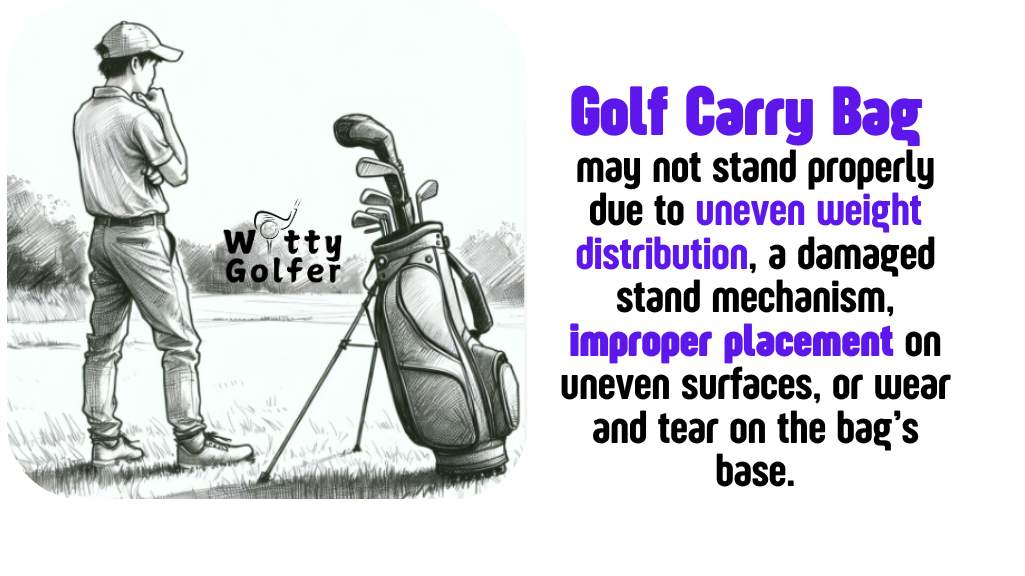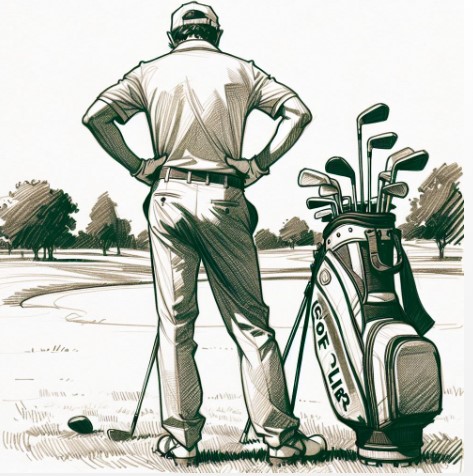A golf carry bag may not stand properly due to uneven weight distribution, a damaged stand mechanism, improper placement on uneven surfaces, or wear and tear on the bag’s base. Ensuring proper weight balance, maintaining the stand, and placing the bag on stable ground can resolve most issues.
| Issue | Percentage of Cases | Common Causes | Recommended Solution |
|---|---|---|---|
| Uneven Weight Distribution | 45% | Poor club arrangement | Reorganize clubs and accessories |
| Damaged Stand Mechanism | 30% | Wear and tear, improper handling | Repair or replace damaged components |
| Placement on Uneven Surfaces | 20% | Slopes, soft terrain | Choose stable ground for placement |
| Worn or Damaged Base | 5% | Dragging the bag, wear over time | Inspect regularly, repair or replace |

Understanding the Basics of Golf Carry Bags
Before identifying the problem, it’s essential to understand the standard features of a golf carry bag. A well-designed bag typically includes:
- Stand Mechanism: Most carry bags come with a built-in stand system that allows them to remain upright when placed on the ground.
- Weight Distribution: A lightweight yet durable structure ensures the bag is easy to carry while evenly balancing its contents.
- Materials: Commonly made from nylon or polyester, carry bags are designed to withstand wear and tear while keeping clubs secure.
- Adjustable Straps: Straps provide comfort during transportation and play a role in maintaining bag stability.
If your golf carry bag isn’t standing properly, it’s likely due to issues in one or more of these components.
Common Reasons Why Golf Carry Bags Fail to Stand

1. Uneven Weight Distribution
The most frequent cause of instability in a golf bag is uneven weight distribution. If your clubs, balls, or accessories are not evenly spread out, the bag might lean to one side or collapse entirely.
How to Identify:
Check if one side of the bag feels heavier than the other when you lift it. Also, observe whether the bag tips consistently in a specific direction.
Solution:
- Rearrange the clubs and other items. Place heavier clubs, such as woods and drivers, in the central compartments, and lighter clubs on the sides.
- Use dedicated pockets for balls, tees, and accessories to avoid overloading one side.
| Issue | Effect | Solution |
|---|---|---|
| Uneven club placement | Bag leans to one side | Balance clubs centrally |
| Overloaded pockets | Bag becomes lopsided | Distribute items across all compartments |
2. Damaged Stand Mechanism
Carry bags with a stand mechanism rely on spring-loaded legs to maintain stability. Over time, these legs may become bent, stiff, or completely non-functional due to regular wear and tear or mishandling.
How to Identify:
Examine the legs for visible damage, such as bending or warping. Test the spring action by opening and closing the stand; resistance or uneven movement indicates a problem.
Solution:
- Repair or Replace: If the legs are slightly bent, you may try straightening them gently. For severe damage, replacing the legs or the entire stand mechanism might be necessary.
- Prevent Further Damage: Always set the bag down on flat, stable surfaces to avoid strain on the legs.
3. Improper Surface Placement
Golf courses often have uneven terrain, which can make it difficult for carry bags to stand upright. Placing your bag on a slope, soft ground, or thick grass might cause it to topple over.
How to Identify:
Notice if the bag stands well on flat surfaces but struggles on uneven or sloping areas.
Solution:
- Look for a flat, stable surface before placing your bag down.
- Use a golf cart or trolley if the terrain is particularly challenging for a carry bag.
| Surface Type | Likelihood of Instability | Recommendation |
|---|---|---|
| Flat, firm ground | Low | Ideal for placing carry bags |
| Uneven or sloping ground | High | Adjust placement or use additional support |
| Wet or soft surfaces | High | Avoid placing the bag in such conditions |
4. Worn or Broken Base
The base of a golf carry bag plays a crucial role in its stability. If the base is cracked, uneven, or damaged, the bag may not stand properly.
How to Identify:
Inspect the bottom of the bag for visible cracks or wear. Place the bag on a flat surface to see if it wobbles.
Solution:
- Repair: Some minor issues, like small cracks, can be fixed with adhesive or tape.
- Replacement: For significant damage, consider replacing the base or the entire bag.
- Maintenance: Avoid dragging the bag across rough surfaces to prolong the life of the base.
5. Improper Adjustment of Straps
Straps that are too loose or improperly adjusted can throw off the balance of the bag, making it unstable when standing.
How to Identify:
Check if the bag tilts awkwardly when placed on the ground, even without any significant weight imbalance.
Solution:
- Tighten or adjust the straps to ensure the bag remains evenly balanced when carried or placed.
- If the straps are worn out, replacing them can improve overall balance and comfort.
Preventive Measures to Ensure Stability
Taking a proactive approach can help keep your golf carry bag in good condition for years. Here are some tips:
1. Distribute Weight Evenly
Always arrange your clubs and accessories to maintain balance. Avoid overloading one side of the bag.
2. Handle With Care
Avoid dropping or throwing your bag onto the ground, as this can damage the stand mechanism and base.
3. Regular Maintenance
Inspect your bag periodically for signs of wear or damage. Tighten any loose screws or bolts in the stand mechanism and clean the base regularly.
4. Invest in Quality
Opt for a durable carry bag from a trusted brand. While these might be more expensive upfront, they often provide better longevity and stability.
When to Replace Your Golf Carry Bag
Despite all efforts, there might come a time when your carry bag is beyond repair. Here are some signs it’s time for a replacement:
- Severely Damaged Base: If the base is cracked or warped beyond repair, stability issues will persist.
- Broken Stand Mechanism: If replacing or repairing the legs is not feasible, it’s better to invest in a new bag.
- Worn Fabric or Zippers: Damage to the fabric or zippers can make the bag unusable over time.
- Persistent Instability: If the bag tips over despite all adjustments, it might be poorly designed or too old.
Why Does My Golf Carry Bag Keep Falling Over?
The main reason a golf carry bag fails to stand is uneven weight distribution. Placing heavier items like golf balls, graphite shafts, or golf clubs unevenly in the bag can throw off its balance. Heavier clubs such as Ping G410 drivers or shorter clubs like wedges should be placed centrally in the bag, while lighter clubs are positioned toward the edges.
Solution:
- Organize your golf equipment thoughtfully for a well-organized golf bag.
- Ensure balanced weight distribution by using full-length dividers or individual divider sleeves.
How Can I Fix a Malfunctioning Stand Mechanism?
Golf stand bags rely on spring-loaded legs to remain upright. If these legs are bent or the springs have weakened, the bag may collapse. This problem is common in lightweight golf bags like Sun Mountain models.
Fix Tips:
- Inspect the stand legs and tighten any loose screws.
- Clean the hinges and springs to remove dirt.
- If the issue persists, consult your golf retailer or the bag’s manufacturer.
Does the Surface Matter When Placing a Golf Carry Bag?
Yes, the surface plays a significant role in your bag’s stability. Placing your bag on hilly golf terrain, soft grass, or uneven ground increases the risk of it toppling over.
Tips:
- Use a golf buggy or cart bag for better stability on challenging terrains.
- For walking golfers, place the bag on firm, flat ground whenever possible.
Are Heavy Bags More Likely to Fall Over?
Yes, bags with higher average weight (e.g., 7-12 pounds) and excessive additional accessories, such as water bottles or rain gear, are more prone to instability. Lightweight golf carry bags are easier to manage and less likely to tip over.
Advice:
- Minimize unnecessary items and only carry essential accessories like a caddy-sized towel, golf gloves, and extra golf balls.
- Alternate shoulders when carrying dual-shoulder strap bags to reduce shoulder strain.
Why Are My Golf Bag Straps Causing Instability?Loose or improperly adjusted straps, whether single straps or double shoulder straps, can throw off your bag’s balance. A poorly balanced bag can tilt and collapse, especially when set down.
Fix Tips:
- Adjust the straps to fit your dominant shoulder comfortably.
- Opt for double shoulder straps to distribute weight evenly and prevent strain.
When Should I Replace My Golf Carry Bag?
If your bag shows signs of wear—such as a damaged base, bent stand legs, or worn-out individual compartments—it may be time to replace it. Modern golf bags like Ghost Golf or Sun Mountain options are designed with durability in mind.
Can Overpacking Cause the Bag to Tip Over?
Yes, overloading your bag with additional pockets full of items like golf gear, extra bottles, or extra gloves can create imbalances. A minimalist walking golfer should focus on carrying only what’s necessary for an afternoon of golf.
Packing Tips:
- Use easy-access pockets like apparel pockets, ball pockets, and beverage pockets wisely.
- Distribute heavier items like clubs and golf balls across separate compartments.
Final Decision
A golf carry bag that doesn’t stand properly can disrupt your game and lead to unnecessary frustration. By understanding the common causes—such as uneven weight distribution, damaged stands, or improper placement—you can take steps to resolve these issues effectively. Regular maintenance, careful handling, and knowing when to replace your bag are key to ensuring a smooth and enjoyable golfing experience.